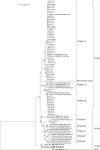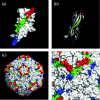In silico analyses of antigenicity and surface structure variation of an emerging porcine circovirus genotype 2b mutant, prevalent in southern China from 2013 to 2015
- PMID: 26758466
- PMCID: PMC4854366
- DOI: 10.1099/jgv.0.000398
In silico analyses of antigenicity and surface structure variation of an emerging porcine circovirus genotype 2b mutant, prevalent in southern China from 2013 to 2015
Abstract
Porcine circovirus type 2 (PCV2) is the pivotal pathogen causing porcine circovirus-associated diseases. In this study, 62 PCV2 isolates were identified from seven farms in southern China from 2013 to 2015 and phylogenetic trees were reconstructed based on whole-genome sequences or the cap gene. In this investigation, PCV2b was the main genotype in circulation throughout these farms. Furthermore, an emerging mutant (PCV2b-1C), isolated from PCV2-vaccinated farms, was the predominant strain prevalent on these farms. In addition, we isolated a new cluster that may represent evolution of the virus through recombination of PCV2b-1A/1B and PCV2b-1C. Finally, we discuss evidence that antigenicity and surface structure variation of the capsid resulted from mutation of the C-terminal loop (Loop CT) of the PCV2b-1C Cap in silico.
Figures






Similar articles
-
Porcine Circovirus Type 2 (PCV2) Vaccines in the Context of Current Molecular Epidemiology.Viruses. 2017 May 6;9(5):99. doi: 10.3390/v9050099. Viruses. 2017. PMID: 28481275 Free PMC article. Review.
-
Prevalence and phylogenetic analysis of the current porcine circovirus 2 genotypes after implementation of widespread vaccination programmes in the USA.J Gen Virol. 2012 Jun;93(Pt 6):1345-1355. doi: 10.1099/vir.0.039552-0. Epub 2012 Mar 7. J Gen Virol. 2012. PMID: 22398315
-
Porcine circovirus type 2 (PCV2) genotyping in Austrian pigs in the years 2002 to 2017.BMC Vet Res. 2020 Jun 15;16(1):198. doi: 10.1186/s12917-020-02413-4. BMC Vet Res. 2020. PMID: 32539835 Free PMC article.
-
Capsid proteins from PCV2a genotype confer greater protection against a PCV2b strain than those from PCV2b genotype in pigs: evidence for PCV2b strains becoming more predominant than PCV2a strains from 2000 to 2010s.Appl Microbiol Biotechnol. 2016 Jul;100(13):5933-43. doi: 10.1007/s00253-016-7459-y. Epub 2016 Mar 28. Appl Microbiol Biotechnol. 2016. PMID: 27020283
-
Genetic variation of porcine circovirus type 2 (PCV2) and its relevance to vaccination, pathogenesis and diagnosis.Virus Res. 2012 Mar;164(1-2):68-77. doi: 10.1016/j.virusres.2011.11.018. Epub 2011 Dec 17. Virus Res. 2012. PMID: 22198217 Review.
Cited by
-
Porcine Circovirus Type 2 (PCV2) Vaccines in the Context of Current Molecular Epidemiology.Viruses. 2017 May 6;9(5):99. doi: 10.3390/v9050099. Viruses. 2017. PMID: 28481275 Free PMC article. Review.
-
Strain-Dependent Porcine Circovirus Type 2 (PCV2) Entry and Replication in T-Lymphoblasts.Viruses. 2019 Sep 2;11(9):813. doi: 10.3390/v11090813. Viruses. 2019. PMID: 31480752 Free PMC article.
-
Structure-Based Design of Porcine Circovirus Type 2 Chimeric VLPs (cVLPs) Displays Foreign Peptides on the Capsid Surface.Front Cell Infect Microbiol. 2018 Jul 9;8:232. doi: 10.3389/fcimb.2018.00232. eCollection 2018. Front Cell Infect Microbiol. 2018. PMID: 30038901 Free PMC article.
-
Porcine circovirus genotypes and their copathogens in pigs with respiratory disease in southern provinces of Vietnam.Arch Virol. 2021 Feb;166(2):403-411. doi: 10.1007/s00705-020-04878-y. Epub 2021 Jan 3. Arch Virol. 2021. PMID: 33392818
-
Epidemic and genetic characterization of porcine epidemic diarrhea virus strains circulating in the regions around Hunan, China, during 2017-2018.Arch Virol. 2020 Apr;165(4):877-889. doi: 10.1007/s00705-020-04532-7. Epub 2020 Feb 13. Arch Virol. 2020. PMID: 32056002 Free PMC article.
References
MeSH terms
Substances
LinkOut - more resources
Full Text Sources
Other Literature Sources
Miscellaneous

